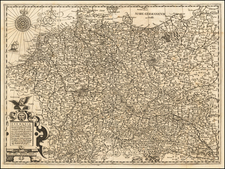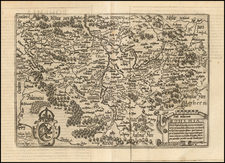Battle of Štěrbohol (Battle of Prague) May, 1757
Extremely rare battle map, offering a detailed visual account of the pivotal Battle of Štěrbohol, which took place on May 6, 1757. This battle was a significant event during the Seven Years' War, a global conflict that pitted some of the era's major powers against each other.
Oriented with south at the top, the map shows the battle in remarkable detail.
At Štěrbohol, immediately on the eastern edge of Prague, the Prussian forces, under the leadership of King Frederick the Great, faced off against the Austrian army. The map traces the movements of both armies, capturing the strategic maneuvers that led to the Prussian victory and the consequent Austrian defeat. The battle was instrumental in establishing Prussia's military reputation in Europe.
Besides the military movements, the map also provides an intricate portrayal of the topography surrounding Prague. The city's fortifications are prominently depicted, signaling their military importance during the period. However, within Prague's walls, only a few isolated structures, presumably of military significance, are illustrated. A particularly notable feature is the depiction of three pontoon bridges in the Podbaba region. Such bridges were crucial for troop movements and provided strategic advantages during military campaigns.
Outside Prague's fortified walls, the map carefully notes individual villages, giving viewers a sense of the wider landscape in which the battle occurred. Two distinctive landmarks are recorded: the Invalid House and a notable homestead. These could have been significant either for their military value or as recognizable landmarks for troops and commanders.
Battle of Štěrbohol (Battle of Prague)
The Battle of Štěrboholwas a pivotal confrontation that unfolded on May 6, 1757, during the Seven Years' War. The battlefield, set just outside the historic city of Prague in Bohemia, lay near the village of Štěrbohol and other adjacent regions like Libeň, Kyje, and Hostavice.
Combatants:
-
Prussian Army: Commanded by King Frederick II of Prussia, or Frederick the Great, the Prussian forces were on a mission to expand their territorial gains. Fresh from victories the prior year, they aspired to neutralize Austria by seizing its allied stronghold, Bohemia.
-
Austrian Army: Positioned under the leadership of Prince Charles of Lorraine, the Austrians sought to defend their territories against the ambitious Prussian onslaught.
Key Military Figures:
-
King Frederick II (Prussia): An iconic figure of his time, Frederick was renowned not just as a ruler but as a military tactician whose strategies have been studied for generations.
-
Prince Charles of Lorraine (Austria): Empress Maria Theresa's brother-in-law, Prince Charles, although occasionally overshadowed by Frederick's military prowess, was a competent strategist in his own right.
-
Field Marshal Kurt Christoph Graf von Schwerin (Prussia): His significant contribution to the battle, including his untimely death, played a considerable role in shaping the battle's outcome.
Battle Dynamics:
-
The onset of the battle was marked by the Prussians launching a strategic artillery assault. This was succeeded by waves of infantry charges. The terrain around Štěrbohol and the areas leading up to Prague, including regions like Záběhlice and Vinohrady, posed challenges, making advances arduous.
-
In a turning point, Field Marshal von Schwerin, seeing the hesitancy among Prussian troops, led a daring charge after seizing a regimental flag. This brave act cost him his life but became the catalyst for the subsequent Prussian advance.
-
The Austrians, despite their valiant resistance, started to waver, resulting in a retreat towards the heart of Prague.
-
The victory, however, came at a steep price for the Prussians in terms of casualties. This win led them to lay siege to Prague, though the historic city stood resilient for a considerable time.
Aftermath:
While Štěrbohol was a tactical win for the Prussians, the subsequent events did not align with their aspirations. Their Siege of Prague became protracted, and the Austrians, rallying their forces, confronted the Prussians at the Battle of Kolin, where Frederick's army faced a significant setback.










![[ Holy Roman Empire ] S. Imperium Romano-Germanicum oder Teutschlenad mit Seinen Angrantzenden Konigreichen und Provincien,...](https://storage.googleapis.com/raremaps/img/small/98433.jpg)
![[ Bohemia / Czech Republic ] Bohemiae Nova Descriptio Tabula XVII](https://storage.googleapis.com/raremaps/img/small/95795.jpg)

![[Nové Zámky/Érsekújvár] Abris der Festung Neuheusel Wie solche von Kay May: Armada underm General Bocquoy Belagert gewesen](https://storage.googleapis.com/raremaps/img/small/75327.jpg)
![[ Tribal Germany ] Germania Antiqua in IV magnos populaos in minores et minimos distincta et Regiones Danubium…1785](https://storage.googleapis.com/raremaps/img/small/97958.jpg)